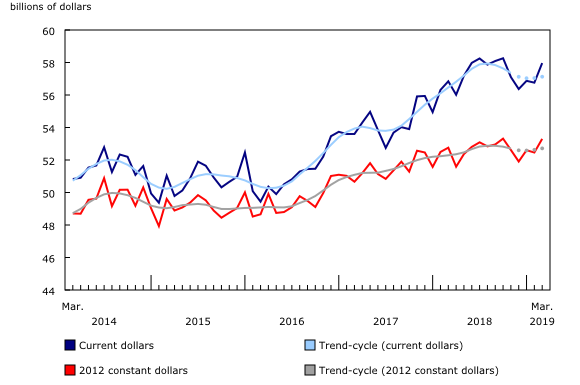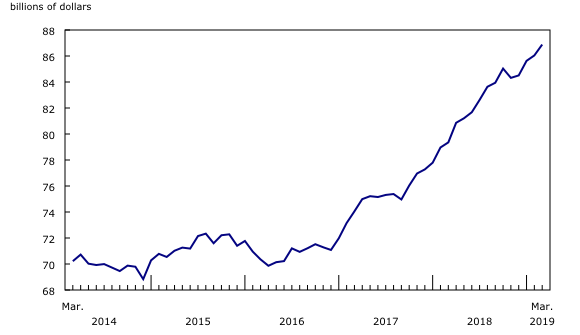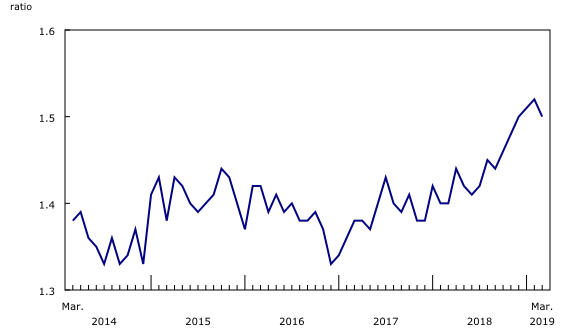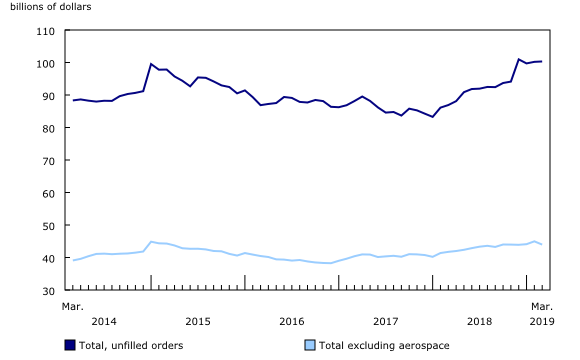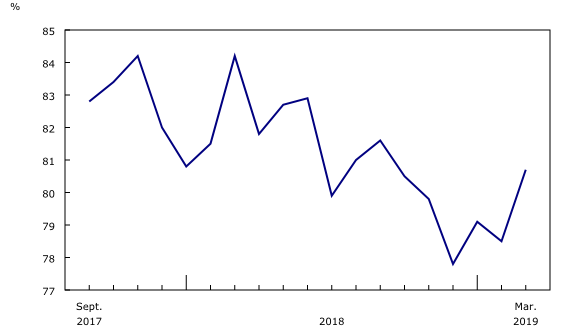Monthly Survey of Manufacturing, March 2019
Archived Content
Information identified as archived is provided for reference, research or recordkeeping purposes. It is not subject to the Government of Canada Web Standards and has not been altered or updated since it was archived. Please "contact us" to request a format other than those available.
Released: 2019-05-16
Manufacturing sales increased 2.1% to $58.0 billion in March, following a 0.2% decrease in February and a 0.9% gain in January. The transportation equipment, petroleum and coal product, and primary metal industries posted the largest gains in March.
Overall, sales were up in 12 of 21 industries, representing 56.4% of the Canadian manufacturing sector.
In volume terms, manufacturing sales rose 1.6%.
Transportation equipment, petroleum and coal product, and primary metal industries post the largest gains
Sales of transportation equipment increased 4.5% to $11.1 billion in March, following three consecutive monthly decreases. The gain largely stemmed from a 6.5% increase in motor vehicle sales, reflecting increased sales at all motor vehicle assembly plants, as several of them drew down accumulated inventories. In constant dollars, sales rose 5.9% in the motor vehicle industry in March.
In the petroleum and coal product industry, sales rose for the third consecutive month, up 8.2% to $6.2 billion. This reflected higher sales from refineries in both western and eastern Canada. In volume terms, sales rose 3.2% in the petroleum and coal product industry in March.
Primary metal sales rose 5.3% to $4.4 billion in March, following two consecutive monthly declines. Widespread gains in March were led by the iron and steel mills and ferro-alloy industry, the non-ferrous metal (except aluminum) production and processing industry, and the alumina and aluminum production and processing industry.
Sales were also up in the aerospace product and parts (+7.1%), machinery (+2.2%), miscellaneous (+7.2%) and computer and electronic product (+3.8%) industries.
These increases were partially offset by declines in the paper (-2.2%), electric equipment, appliance and component (-4.6%) and plastic and rubber product (-1.3%) industries.
Sales increase in eight provinces
Sales were up in eight provinces in March, led by gains in Ontario, Alberta and Quebec. Sales declined in Manitoba and Saskatchewan.
Following a 1.6% decrease in February, sales in Ontario increased 1.7% to $26.5 billion. The gain reflected mainly higher sales in motor vehicle manufacturing, which rose 6.6%. All motor vehicle assembly plants reported a sales increase in March. Higher sales were also reported in the primary metal (+7.0%) and computer and electronic product (+6.4%) industries.
Sales in Alberta increased 3.9% to $6.5 billion. The gain reflected higher sales of petroleum and coal products, which rose 15.9% in March, following a 20.6% increase in February. Higher volumes and prices contributed to the increase of petroleum and coal products.
In Quebec, sales increased 1.7% to $14.4 billion after a 4.0% gain in February. Higher production was reported in the aerospace product and parts industry (+8.6%) as the depreciation of the Canadian dollar helped push production values higher for those who report in US dollars. Higher sales were also reported in the petroleum and coal product, chemical and machinery industries.
Inventory levels increase
Total inventories rose for the fourth consecutive month, up 1.0% to $86.9 billion, with gains in 12 of 21 industries. The inventory level in March was 9.5% higher than in March 2018. Monthly increases were reported in transportation equipment (+3.2%), chemicals (+1.9%), machinery (+1.3%) and food (+1.2%). These gains were partially offset by inventory declines in primary metals (-2.9%).
The inventory-to-sales ratio decreased to 1.50 in March from 1.52 in February. This ratio measures the time, in months, that would be required to exhaust inventories if sales were to remain at their current level.
Unfilled orders rise
Unfilled orders increased 0.1% to $100.3 billion despite declines in 11 of 21 industries. This was the fifth gain in six months. Higher unfilled orders were reported in aerospace product and parts (+2.0%). Of the industries reporting a decline, the largest decrease was in machinery (-4.5%).
New orders were up 1.5% to $58.1 billion as a result of higher orders in the aerospace product and parts, petroleum and coal product and motor vehicle industries.
Capacity utilization rate
The unadjusted capacity utilization rate for the manufacturing sector increased from 78.5% in February to 80.7% in March.
Overall, the capacity utilization rate rose in 17 of 21 industries, with the petroleum and coal product and transportation equipment industries posting the largest increases in March.
The capacity utilization rate for the petroleum and coal product industry increased for the fourth consecutive month, rising 4.7 percentage points to 89.9% in March. This increase reflected higher production at refineries in both western and eastern Canada.
The capacity utilization rate for the transportation equipment industry rose 4.4 percentage points to 85.1% in March. The increase was mostly attributable to higher production at motor vehicle assembly plants.
Sustainable Development Goals
On January 1, 2016, the world officially began implementation of the 2030 Agenda for Sustainable Development—the United Nations' transformative plan of action that addresses urgent global challenges over the next 15 years. The plan is based on 17 specific sustainable development goals.
The Monthly Survey of Manufacturing is an example of how Statistics Canada supports the reporting on the Global Goals for Sustainable Development. This release will be used in helping to measure the following goal:

Note to readers
Monthly data in this release are seasonally adjusted and are expressed in current dollars unless otherwise specified.
For information on seasonal adjustment, see Seasonally adjusted data – Frequently asked questions. For information on trend-cycle data, see Trend-cycle estimates – Frequently asked questions.
With this release, unadjusted estimates of sales of goods manufactured, inventories and orders in tables 16-10-0047-01 and 16-10-0048-01 have been revised back to January 2013 and back to January 2011 for the seasonally adjusted data. Real manufacturing sales, orders, inventory owned and inventory-to-sales ratio estimates in table 16-10-0013-01 have been revised back to January 2011.
Non-durable goods industries include food, beverage and tobacco products, textile mills, textile product mills, clothing, leather and allied products, paper, printing and related support activities, petroleum and coal products, chemicals, and plastics and rubber products.
Durable goods industries include wood products, non-metallic mineral products, primary metals, fabricated metal products, machinery, computer and electronic products, electrical equipment, appliances and components, transportation equipment, furniture and related products, and miscellaneous manufacturing.
Production-based industries
For the aerospace and shipbuilding industries, the value of production is used instead of the value of sales of goods manufactured. The value of production is calculated by adjusting monthly sales of goods manufactured by the monthly change in inventories of goods in process and finished products manufactured. The value of production is used because of the extended period of time that it normally takes to manufacture products in these industries.
Unfilled orders are a stock of orders that will contribute to future sales assuming that the orders are not cancelled.
New orders are those received, whether sold in the current month or not. New orders are measured as the sum of sales for the current month plus the change in unfilled orders from the previous month to the current month.
Manufacturers reporting in US dollars
Some Canadian manufacturers report sales, inventories and unfilled orders in US dollars. These data are then converted to Canadian dollars as part of the data production cycle.
For sales, based on the assumption that they occur throughout the month, the average monthly exchange rate for the reference month established by the Bank of Canada is used for the conversion. The monthly average exchange rate is available in table 33-10-0163-01. Inventories and unfilled orders are reported at the end of the reference period. For most respondents, the noon spot exchange rate on the last working day of the month is used for the conversion of these variables.
However, some manufacturers choose to report their data as of a day other than the last day of the month. In these instances, the daily average exchange rate on the day selected by the respondent is used. Note that because of exchange rate fluctuations, the daily average exchange rate on the day selected by the respondent can differ from both the exchange rate on the last working day of the month and the monthly average exchange rate. Daily average exchange rate data are available in table 33-10-0036-01.
Real-time data tables
Real-time data tables 16-10-0118-01, 16-10-0119-01, 16-10-0014-01 and 16-10-0015-01 will be updated on May 28.
Next release
Data from the Monthly Survey of Manufacturing for April will be released on June 18.
Contact information
For more information, contact us (toll-free 1-800-263-1136; 514-283-8300; STATCAN.infostats-infostats.STATCAN@canada.ca).
For more information, or to enquire about the concepts, methods or data quality of this release, contact Bechir Oueriemmi (613-951-7938; bechir.oueriemmi@canada.ca) or Michael Schimpf (613-863-4480; michael.schimpf@canada.ca), Mining, Manufacturing and Wholesale Trade Division.
- Date modified:




